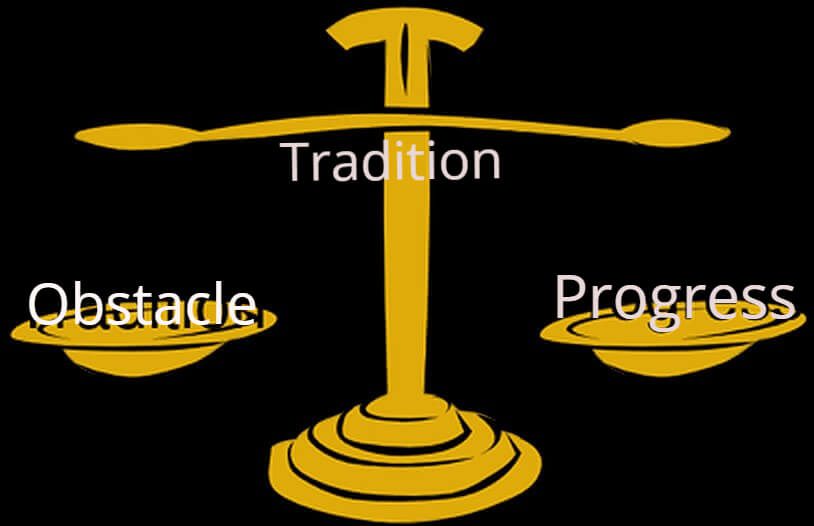Shivani examines how socio-religious traditions cause drag and hinder our progress. An exclusive for Different Truths.
 People say that tradition is a feeling that makes a person’s life worth living, wrapping it in a way the people know where they belong. It sets to define a person’s roots but history puts it into the books of an evil termite, which is making our minds, personality and hearts more shallow. This would lead us to a stage where we will see humanity becoming worthless.
People say that tradition is a feeling that makes a person’s life worth living, wrapping it in a way the people know where they belong. It sets to define a person’s roots but history puts it into the books of an evil termite, which is making our minds, personality and hearts more shallow. This would lead us to a stage where we will see humanity becoming worthless.
People say that tradition is a feeling that makes a person’s life worth living, wrapping it in a way the people know where they belong. It sets to define a person’s roots but history puts it into the books of an evil termite
It is something that holds the entire society, educated or not, back to that extent where we, as a society, feel helpless. More than tradition being actually followed, it comes under a mental dilemma, which keeps us from progressing economically, as a country and also as a large mass of followers.
All the developed countries and the major powers of the world are continuously progressing because they are not divided by the narrow domestic walls of mental barriers and social obstacles. There was a time when they also followed certain traditions, which caused them a great amount like, ‘The War of Crusades’ in Europe, was a war between the Muslims and the Christians. ‘The French War’ between the Catholics and the Huguenots, which lasted for almost 36 years. These caused a million deaths, which is a mere example of the statement that tradition can cause a lot of suppression and backwardness.
India as a country of extremely diverse culture with a plethora of traditions being followed through the country is suppressed under the rock of something known as social and mental barriers contributed by our gushing mythology and scripts.
India as a country of extremely diverse culture with a plethora of traditions being followed through the country is suppressed under the rock of something known as social and mental barriers contributed by our gushing mythology and scripts. Before the independence movement in the country taking off with the first war in 1875, an early Indian nationalist stated, ‘the main obstacle in India’s progress is its socio-economic and religious backwardness’.
Raja Ram Mohan Roy, the father of Indian renaissance and a prophet of Indian nationalism protested against the custom of ‘sati’, ‘idol worship’ and ‘child marriages’. This idea must have been very fraught for the people of dependant India but really benefitted the society once it was implemented. Raising our voice and taking similar steps against some of the ridiculous traditional activities and myths that will lead to the progress of this nation.
Raja Ram Mohan Roy, the father of Indian renaissance and a prophet of Indian nationalism protested against the custom of ‘sati’, ‘idol worship’ and ‘child marriages’. This idea must have been very fraught for the people of dependant India but really benefitted the society once it was implemented.
Religious violence in India includes acts of violence by followers of one religious group against followers and institutions of another religious group, often in the form of rioting:
² Exodus of Kashmiri Hindus.
² Gujarat communal riots (1969)
² Anti-Sikh Riots (1984)
² Religious involvement in North-East India Militancy.
² Anti-Hindu violence.
² Violence against Muslims.
² Anti-Christian violence.
² Anti-atheist violence.
According to civil rights groups, there is an extensive list of brutalities in the name of religion in India. For instance, the killing of at least 2,000 Muslims in Gujarat, in 2002. Since independence in 1947, the Muslim community has been subject to and engaged in sectarian violence in Gujarat state. In 2002, Hindu extremists carried out acts of violence against the Muslim minority population. The starting point for the incident was the Godhra train burning, which was allegedly done by Muslims. During the incident, young girls were sexually assaulted, burned or hacked to death. These rapes were condoned by the ruling BJP, whose refusal to intervene lead to the displacement of 200,000. Death toll figures range from the official estimate of 790 Muslims and 254 Hindus killed, to 2,000 Muslims killed. The then Chief Minister Narendra Modi has also been accused of initiating and condoning the violence, as have the police and government officials, who took part, as they directed the rioters and gave lists of Muslim-owned properties to the extremists. In 2007, Tehelka magazine released, The Truth: Gujarat 2002, which was a report based on a six-month-long investigation involving video sting operations. It stated that the violence was made possible by the support of the state police and the then Chief Minister of Gujarat Narendra Modi for the perpetrators. The report and the reactions to it were widely covered in Indian and international media.
In 2002, Hindu extremists carried out acts of violence against the Muslim minority population. The starting point for the incident was the Godhra train burning, which was allegedly done by Muslims. During the incident, young girls were sexually assaulted, burned or hacked to death. These rapes were condoned by the ruling BJP, whose refusal to intervene lead to the displacement of 200,000. Death toll figures range from the official estimate of 790 Muslims and 254 Hindus killed, to 2,000 Muslims killed.
Apart from this piece of information giving examples of the various communal riots in modern India, there are many myths and superstitions that wrap this whole concept into one conclusion. We are just living under this dilemma and offering our entire selves to something so unpredictable trying to reach out to the almighty while making money on that basis by creating names for gods and their statues. If you want peace, if all of us are looking for inner peace, we are all looking in the same direction, which is fooling our beliefs and the ones that look in the other direction by following the right way, through meditation, prayers in peace and progress are the ones who are going to be the most successful people in their own ways.
Photo from the Internet





 By
By


 By
By
Very mature thoughts,we actually need this thought process to progress